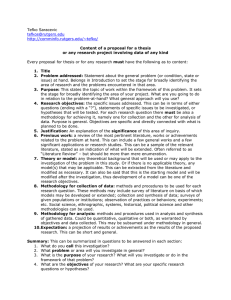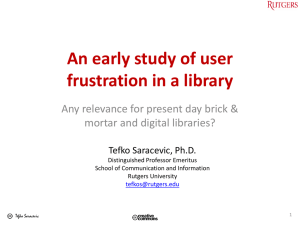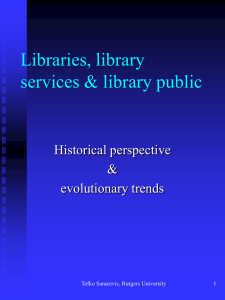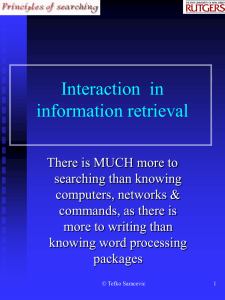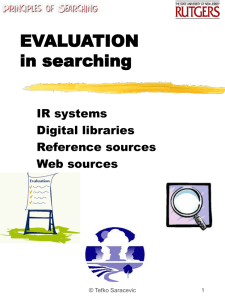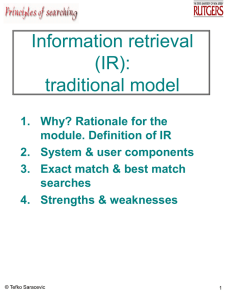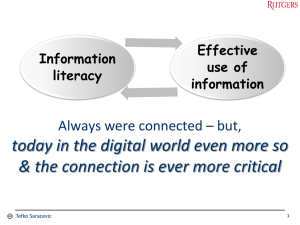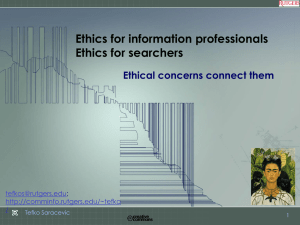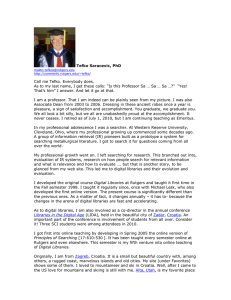Information seeking.ppt
advertisement
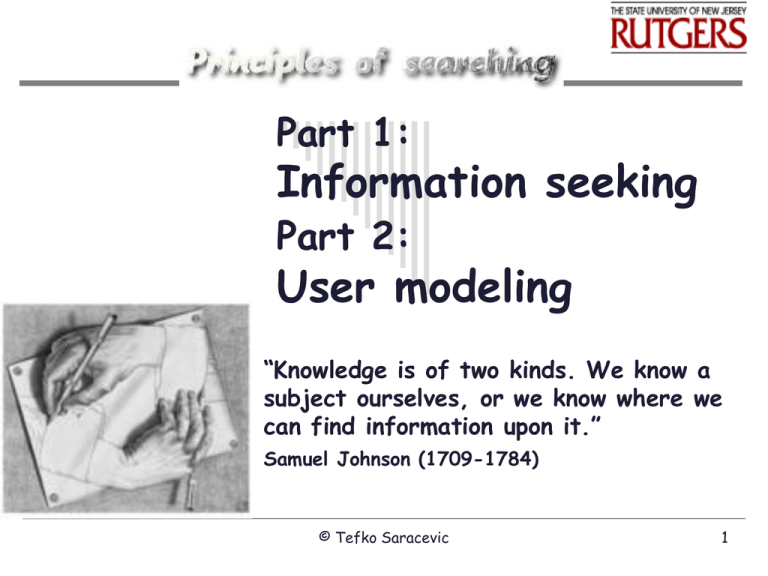
Part 1: Information seeking Part 2: User modeling “Knowledge is of two kinds. We know a subject ourselves, or we know where we can find information upon it.” Samuel Johnson (1709-1784) © Tefko Saracevic 1 But what when we do not know where to find it? And we still want information? © Tefko Saracevic 2 Part 1: Information seeking © Tefko Saracevic 3 Definitions Information – many different senses Information-as-process – the communication act Information-as-knowledge – an increase or reduction in uncertainty Information-as-thing – objects that may impart information (Buckland, 1991) Information is anything that can change person’s knowledge (Belkin, 1978) © Tefko Saracevic 4 Definitions … Information as we consider it includes objects in the world potentially conveying information what is transferred from people or objects to a person’s cognitive system components of internal knowledge in people’s mind To seek information people seek to change their state of their knowledge © Tefko Saracevic 5 Definitions … Information seeking Process in which humans purposefully engage in order to change their state of knowledge (Marchionini, 1995) A conscious effort to acquire information in response to a need or gap in your knowledge (Case, 2002) The process of construction within information seeking involves fitting information in with what one already knows and extending this knowledge to create new perspectives (Kuhlthau, 2004) © Tefko Saracevic 6 Information seeking as an area of study Long history in a number of fields part of the broader area of studies in human information behavior In library & information science also related to studies on users & use, involving variety of fields & populations information search process studies on roles of mediators & user modeling Literature diverse and large © Tefko Saracevic 7 Central question In information seeking studies: What factors – variables – are involved when people seek information? Translation: What is really going on when we go about finding information about something? In everyday life we really do not care – we just go on doing it – but as professionals we have to understand the process in order to deal with it The question has many sub-questions such as in relation to what are people seeking information? how is information seeking (as a broader process) related to information search (as a narrower process)? © Tefko Saracevic 8 In pursuit of central question A number of models have been developed enumerating factors & relationships involved A few theories have been proposed suggesting explanations Number of studies have connected information seeking to specific aspects – reviewed here: tasks in information seeking information seeking and the search process © Tefko Saracevic 9 Task Generally, information seeking is not an end in itself Generally, it serves a work task task is a process in relation to which information is needed Tasks have been categorized from simple to complex (and a number in-between) complex tasks have a number of sub-tasks the more complex a task the complexity of information needed increases © Tefko Saracevic 10 Summary of findings Byström's (1999) formulated 11 statements from results of information seeking studies: S1: as soon as information acquisition requires an effort people as sources are more popular than documentary sources. S2: the more information types are needed, the greater the share of people as sources. S3: the more information types are needed, the greater the share of general-purpose sources and the smaller the share of taskoriented sources. S4: the more information types are needed, the more sources are used. S5: the internality of different source types is loosely connected to the information types. © Tefko Saracevic 11 summary (cont.) S6: the higher the degree of task complexity, the more probable is the need for multiple information types: first task information, then task and domain information, and finally task, domain and [problem] solving information. S7: the higher the degree of task complexity, the more information types are needed, and the greater the share of people as sources and the smaller the share of documentary sources. S8: the higher the degree of task complexity, the more information types are needed and the greater the share of general-purpose sources and the smaller the share of task-oriented sources. S9: the higher the degree of task complexity, the more information types are needed, and the higher the number of sources used. S10: task complexity is distinctly related to increasing internality of people as sources and decreasing internality of documentary sources. S11: Increasing task complexity fosters the use of people as sources. © Tefko Saracevic 12 Information seeking & searching Several studies connected information seeking with the search process posit information seeking as a broader context (process) for a more specific process of searching Exemplify factors – variables – involved showing that there is more to searching than we think usually © Tefko Saracevic 13 Kuhlthau model of the information search process (ISP) Originally studying pupils & undergraduates but subsequently looking at other user groups as well, Kuhlthau (1991, 2004) formulated a sixstage information search process (ISP), each stage representing differing needs, behaviors, and cognitive and affective states © Tefko Saracevic 14 Kuhlthau six stages 1. 2. 3. 4. 5. 6. Initiation: user “becomes aware of a lack of knowledge or understanding” Selection: user needs to “identify and select the general topic to be investigated” Exploration: user needs to “investigate information on the general topic in order to extend personal understanding” Formulation: user forms “a focus from the information encountered” Collection: user needs “to gather information related to the focused topic” Presentation: user completes the search and presents findings © Tefko Saracevic 15 Kuhlthau model (cont.) Each stage – task - in the information search process incorporates three realms: 1. Affective (feelings) 2. Cognitive (thoughts) 3. Physical (actions) “The process of information seeking involves construction in which the user actively pursues understanding and seeks meaning from the information encountered over a period of time.” Links the process to reduction of uncertainty © Tefko Saracevic 16 Kuhlthau model (cont.) Tasks Initiation Selection Exploration Formulation Collection Presentation ----------------------------------------------------------------------------------------------------------------------------------------------------→ Feelings uncertainly (affective) Thoughts (cognitive) Actions (physical) optimism confusion frustration doubt clarity sense of satisfaction or direction/ disappointment confidence vague-------------------------------------→focused -----------------------------------------------→ increased interest seeking relevant information----------------------------→seeking pertinent information exploring documenting © Tefko Saracevic 17 Uncertainty Principle Uncertainty is a cognitive state which commonly causes affective symptoms of anxiety and lack of confidence. Uncertainty and anxiety can be expected in the early stages of the information search process. © Tefko Saracevic 18 Uncertainty Principle The affective symptoms of uncertainty, confusion, and frustration are associated with vague, unclear thoughts about a topic or question. As knowledge states shift to more clearly focused thoughts, a parallel shift occurs in feelings of increased confidence. Uncertainty due to a lack of understanding, a gap in meaning, or a limited construction initiates the process of information seeking. © Tefko Saracevic 19 Uncertainty Principle Uncertainty initiates the process of information seeking Corollary Process Formulation Redundancy Mood Prediction Interest © Tefko Saracevic Definition Constructing meaning Forming a focused perspective Encountering the expected and unexpected Assuming a posture or attitude Making choices based on expectations Increasing intellectual engagement 20 Model for information system design and use (Allen, 1996) Steps needed to get to the last step: 1. Needs analysis: determining user goals, purposes, and objectives; 2. Task analysis: determining the tasks and activities that users accomplish in meeting their needs; 3. Resource analysis: investigating the resources (both cognitive and social) that are used in completing the tasks; 4. User modeling: synthesizing needs, tasks, and resources; and 5. Designing for usability: assessing how users’ needs, tasks, and resources interact with system characteristics to create usable systems – also can be considered for use of resources © Tefko Saracevic 21 The iterative search process ( copy from Hembrook et al. 2005) © Tefko Saracevic 22 Part 2: User modeling © Tefko Saracevic 23 Definition User modeling is a process of identifying, understanding, and defining user information needs, context, requirements, and preferences, together with factors or attributes in the profile of the user that affect subsequent search for information © Tefko Saracevic 24 Definition … in addition But user modeling should also deal with identifying user’s conceptions about how the information system or resource works, together with related expectations, with possible explanations on how it really works and what could be really expected © Tefko Saracevic 25 in other words In user modeling you identify not only everything about the information need and question at hand but also a number of other factors inherent with the user that may be a guide or even be decisive in selection of resources, search strategy and tactics, evaluation and provision of results and use the occasion to verify user conceptions and expectations and possibly provide reality explanations – there could be a mismatch © Tefko Saracevic 26 User modeling is user+ Identifying elements about a user that impact interaction, selection of resources searching, types of retrieval … Three general categories: information requirements (need, context …) user profile: general user characteristics & attributes user mental model of system/resource & expectations © Tefko Saracevic 27 Information requirements Informational questions what is the problem, task at hand that generated a need for information? what is the context, environment of that? what information is needed for that problem/task? what is the question? what will the information be used for? what are any requirements, restrictions on the type of information needed? what information resources were already utilized? any history of previous efforts? results? © Tefko Saracevic 28 Information requirements (cont.) Cognitive, affective state of user: how much does the user know about the topic of the question at hand? how uncertain is the user? how much wanted, how fast? tolerance for amount, variety of information? © Tefko Saracevic 29 User profile Demographic data about the user that may be relevant for search education subject, level relation to problem/task at hand job, profession, position age group, if relevant gender if relevant language skills, if relevant other factors, as specific to a given information need & question © Tefko Saracevic 30 User profile - stereotypes At times user stereotypes are applied in user modeling common characteristics of a group of users and their needs e.g. third graders, PhD dissertation students, patent attorneys a question on black holes by an astronomer requires search of different resources than a black hole question by a tenth grader these exhibit similar needs and information behavior © Tefko Saracevic 31 stereotypes (cont.) Study and application of user stereotypes is used in computer science & other fields to design & adapt components of an information system to user requirements e.g. interface design recommender systems apply in machine learning Looking for characteristics that may be applied in personalization of automated processes p.s. term "stereotype” is a bit loaded, thus other related terms are being used as well © Tefko Saracevic 32 User mental model of system, resource Conceptions that user has about the system, resource, mediator … at hand for the submitted need what does the user think the system can accomplish? what are the expectations? Used to compare, match with reality of system possibilities and expectations may affect user changing other aspects © Tefko Saracevic 33 Conclusions Searching is always done in a context of information seeking by a user (or a group of users) – the user certainly treats it that way understanding user’s information seeking is necessary to place the role & define the conduct of a given search Information seeking has many dimensions User modeling is your effort to understand and effectively apply relevant dimensions in a search © Tefko Saracevic 34 these are not graphic models of user modeling, (unless???) but they are fun … © Tefko Saracevic 35 can you figure out people walking up & down the steps? thank you M. C. Escher © Tefko Saracevic 36 you can find more on the site of M.C. Escher Foundation & in many lectures on geometry, psychology, illusions. As far as I know, this is the first time they are used in a lecture on user modeling. Why not? © Tefko Saracevic 37
